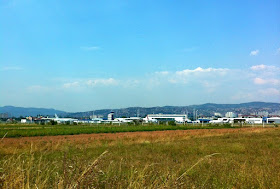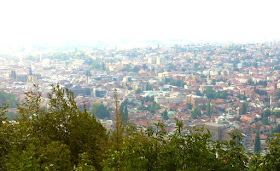 |
Akiko in kitchen of 17c.
Bosnian nobleman's house -
The Svrzo's House. |
Blog covers 3 main sites visited this day: Sarajevo War Tunnel, Svrzo's House, and the National Museum, plus a few others!
SARAJEVO WAR TUNNEL
Sarajevo is also dubbed the City of Hope, for enduring the 3.5 year Siege from 1992-1995 by the Serbs, who were literally neighbors and living amongst each other in Sarajevo. It all started when Bosnia and Hercegovina declared independence from the socialist federation of Yugoslavia - made up of Bosnia and Hercegovina, Croatia, Macedonia, Montenegro, and Slovenia. The Serbs living in Bosnia had a different plan than those who declared independence, so they encircled the city of Sarajevo by stationing themselves in the surrounding hills and assaulted the city - civilians, women, children, and especially cultural and religious buildings of significance - with mortar, machine guns, grenades, etc. Snipers stationed themselves in high-rise buildings and picked-off anyone in the streets. Over 11,000 civilians and 1,500 children were killed in Sarajevo. This became the longest siege in modern warfare. Air strikes against Serbian military strongholds by NATO, of which the United States played a large role in, finally pressured Slobodan Milosevic of Yugoslavia (yup, THAT guy) to come to the negotiation table to end this war. The Dayton agreement was signed in....Dayton, Ohio of all places, at the Wright-Patterson AFB.

During the Siege, there was no way to get any supplies in to the city. The airport was supposedly a neutral area controlled by UN, but anyone who tried to cross the runway was shot. On the other side of the airport was a free Bosnian-held territory up into the mountains. If the Bosnians could make it across the airport, they could make it over the mountain and bring back supplies and such.
 |
| View of Sarajevo Airport |
 |
| Entrance to the tunnel |
In January 1993, Bosnian volunteers started digging a tunnel under the airport. It took them 4-months to dig the 800-meter tunnel, which brought hope to the besieged city, and much needed supplies to survive, including weapons purchased from the enemy, the Serbian forces.
We went to the Sarajevo Tunnel Museum via a tour organized by the Sarajevo Tourist Information Bureau. We're glad we did it this way because the museum is on the other side of the airport and not easy to get to by public transportation. The museum is not big at all. They turned the actual house from where the tunnel exited, into the museum. The house is still riddled with bullet holes. The woman who owned the house, who is seen on the introductory video handing out water to the volunteers, now lives next door! We were able to walk about 20 meters of the tunnel.
 |
| Later, tracks were laid in the tunnel so stretchers could be wheeled with the sick and injured. |
SVRZO'S HOUSE
Another interesting place we visited was the Srvzo House. It is one of the best preserved Bosnian nobleman's home in Ottoman times. We were able to walk through the entire house, full of furnishings, to get a good idea of how rich people in Bosnia lived 400 years ago.
 |
| Men's reception room. No women allowed in here! |
 |
| Panorama of men's reception room. |
 |
| Indoor toilet! Very modern for the times.... |
 |
| Bedroom. Slept on floor. Looks like Japanese futon bed! |
 |
| View of girls' room where they learned to embroider and sew. |
 |
| Family dining room. |
 |
| Every room has one of these wood burning stoves. |
 |
| Grand entertainment room, adorned with Persian rugs, Venetian glass, Turkish metalware, etc. |
 |
| Kitchen. |
NATIONAL MUSEUM
The National Museum of Bosnia-Hercegovina was also heavily damaged during the Siege, and it looks like it never quite recovered. The museum houses very old stuff from the 2nd and 3rd century Bosnia, as well as the Sarajevo Haggadah. The most interesting artifacts lie in the botanical garden outside. Huge stone monuments that are carved with different scenery look like grave stones, but they are not. Apparently, these are found all throughout the landscape of Bosnia, but no one really knows why.
 |
| National Museum of BiH is the permanent home to the Sarajevo Haggadah - an illuminated manuscript that contains illustrated traditional text of the Passover Haggadah - and is one of the most important Jewish artifacts, as this is one of the oldest since 1350. The Haggadah has had many close calls, most recently during the Siege of Sarajevo when it was hidden in a bank vault from the Serbian forces. It is insured for $700 million by is priceless. |










































